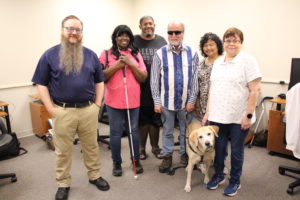Q&A With Assistive Technology Instructor Brad Taylor

On March 2019, the United States Congress designated March 27th as National Assistive Technology Awareness Day. They stated that “assistive technology is any item, piece of equipment, or product system that is used to increase, maintain, or improve the functional capabilities of people with disabilities and older adults.”
Why have a day recognizing Assistive Technology? Assistive Technology, which includes various types of technology and devices, provides emotional and mental benefits to everyone who uses it, regardless of age and abilities.
Our team of specialists provides training on a number of devices to help individuals with vision impairments live life to the fullest. There’s no reason to give up your computer because of vision loss. Thanks to assistive technology our clients learn to use magnifying and/or screen-reading software to confidently navigate the Windows Operating System, master keyboarding word processing programs, read and create email, surf the internet and use today’s popular tech devices like iPhone’s and iPad’s.
In recognition of Assistive Technology Day we sat down with our Adaptive Assistive Technology Instructor Brad Taylor to learn more about his position and the benefits of assistive technology for our clients.
Q. What is assistive technology?
Assistive Technology (AT) is any item, piece of equipment, software program, or product system that is used to increase, maintain, or improve the functional capabilities of persons with disabilities.
For our clients, AT could be something as simple as a large print computer keyboard, or a program that enlarges the computer screen or reads the print on the screen aloud.
Q. How did you become an assistive technology instructor and what does an AT instructor do?
I began working in IT at an agency serving people with visual disabilities. I managed the computer network, repaired and maintained the office computer systems, and assisted the staff with technical issues when needed. When that agency needed a keyboarding instructor, I began working with the clients, teaching them how to touch-type since they could no longer see the computer keyboard. While working with those clients, I began to learn more about their visual disabilities and the types of software that are available to make computers more accessible. After taking some classes and earning teaching endorsements from Florida’s Division of Blind Services (DBS), I began to teach computers at the agency full time.
I’ve now been teaching computers and assistive technology for over 10 years. I work with clients of all ages, with all different levels of vision, teaching them to use Windows and Mac computers, smartphones, and tablets.
Q. What is the most common assistive technology used?
Generally speaking, the most common type of Assistive Technology is probably Screen Magnification programs. Most of our clients still have some usable vision. A Screen Magnifier can magnify the computer screen to the point that even someone who is legally blind can read the text. Many Screen Magnifiers also allow the user to change the colors on the screen in order to provide better contrast, or enlarge the mouse pointer to make it easier to locate visually. Most operating systems such as Windows, have a Screen Magnifier built-in, while other, more fully-features Screen Magnifiers, such as ZoomText, can be purchased separately.
Q. What types of assistive technology classes do you teach?
We train clients in:
- Screen Reader programs for Windows such as JAWS (Job Access with Speech) and NVDA (Non-Visual Desktop Access
- Screen Magnifier programs for Windows such as ZoomText, Fusion, and Windows Magnifier
- Smartphone Screen Readers VoiceOver (iPhone/iPad) and TalkBack (Android)
- Screen Reader for Mac (VoiceOver)
Our training is goal-oriented. For example: If a client just wants to be able to use email and internet to communicate with family and friends, then we’ll work with the client to discover the best way to accomplish their goals. If they’ve been a computer user for years, but are just now having trouble with their vision, then maybe a Screen Magnification program on the computer would work well for them. If the client is a computer novice, but has an iPad, then we can train the client on using VoiceOver, Zoom, and Siri on the iPad.
Clients whose goal is to go to work or school will generally receive training in using the Windows computer with either a Screen Magnifier or Screen Reader, Microsoft Office, Email, and Internet.
Q. Are there ways sighted people and companies can use AT to help those with visual impairments?
Just being aware of some of the different assistive technologies available would be a huge help. Many sighted business owners or managers aren’t even aware of programs such as ZoomText or JAWS that can allow a blind or visually impaired person to perform a job as well as their sighted peers. This leads to a lot of people in hiring positions overlooking qualified applicants who have low vision.
Q. What is your favorite part of being an assistive technology instructor?
When I’m able to help a visually impaired person learn, or perhaps re-learn, a skill that they considered impossible. That is hugely satisfying. Whether it is an older client who hasn’t been able to use Facebook since losing their vision, or a job-seeking client who didn’t think they would be able to use Excel or Word, seeing a client succeed and gain a part of their independence back is very rewarding.
Q. What is something you wish more people knew/understood about assistive technology?
I think most sighted people aren’t aware of how a visually impaired person uses a smartphone, tablet, or computer, or that it is even possible. It would be great if web and app developers understood how blind and visually impaired users access apps and websites and how to ensure that they’re creating products and services that are usable for everyone.
Want to learn more about assistive technology program? Check out our YouTube video.
Join our team and make a difference! We are currently hiring assistive technology instructors.
Click here for our latest jobs and application. Follow us on Facebook or Linkedin for the latest job openings.

